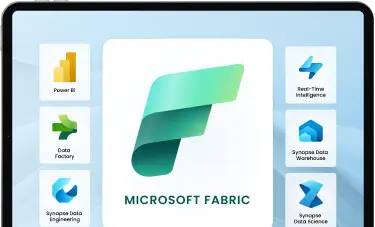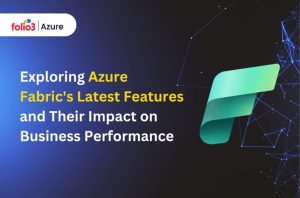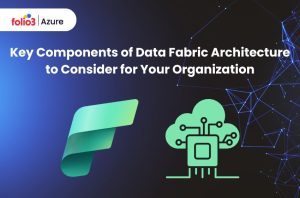Table of Contents
ToggleWith 90% of all data created in the past two years alone, choosing the right data platform has never been more critical. The decision could empower your organization with valuable insights or bog it down with inefficiencies. Two central cloud data warehousing and big data processing contenders are Microsoft Fabric and Snowflake.
Both platforms offer comprehensive and powerful features designed to handle large volumes of data, but understanding the complexities of each can help you make a more informed business decision.
Microsoft Fabric
Microsoft Fabric is a vital part of the Microsoft cloud ecosystem. It provides a robust environment for developing, managing, and deploying large-scale data applications. It integrates easily with other Microsoft services like Azure SQL Database, Power BI, and Azure Machine Learning, enabling seamless data flow and analytics.
Fabric supports traditional and cloud-native applications, allowing workloads to run on-premises, in the cloud, or in a hybrid setting. Its focus on security, through automated data encryption and network isolation, ensures data protection and compliance with global standards.
For businesses using the Microsoft ecosystem, Fabric provides a familiar and powerful platform for maximizing big data and gaining valuable insights.
Pros of Microsoft Fabric
- Seamless Integration: Fabric provides a unified experience with various Azure services, natively connecting with Power BI for interactive data exploration and analysis.
- Scalability: It is notable owing to its parallel processing engine, which allows you to separate computing and storage and independently scale them.
- Price-performance: Users have reported competitive pricing and performance advantages in certain use cases.
Cons of Microsoft Fabric
- Complexity of Use: Although it’s a powerful platform, its wide range of features often requires a steep learning curve. Hence, in-depth knowledge is needed to operate at maximum efficiency.
- Performance at Scale: Some large-scale users have reported performance bottlenecks under specific loads, which might require careful workload management.
Accelerate smart decisions with Microsoft Fabric's unified data and AI analytics.

Snowflake
Snowflake is a cloud-based data storage and analytics service. It’s famous for being a data warehouse built for the cloud, with a platform designed to perform all data-related tasks, including data collection, ingestion, storage, computation, and visualization.
Pros of Snowflake
- Fully Managed Service: Snowflake bills users only for the resources used while managing all the underlying infrastructure, making scalability nearly effortless.
- Simplicity: Snowflake’s ANSI SQL-compatible services offer a low learning curve for users familiar with traditional databases and SQL.
- Performance: It claims to offer faster performance due to its unique architecture that separates compute from storage and utilizes features like automatic scaling to accommodate changes in workload without manual tuning.
Cons of Snowflake
- Integration Challenges: While it integrates seamlessly with some platforms and services, connectivity with specific tools may prove more challenging.
- Cost: Although its pay-as-you-go model can be cost-effective, users must be vigilant about managing costs, especially as they scale.
Comparison Between Microsoft Fabric and Snowflake
1. Architecture
Microsoft Fabric is built on a distributed computing model that is perfect for data warehousing and big data analytics. This approach enables you to handle even the most complex workloads while integrating smoothly with the Azure ecosystem.
With distributed computing, your data is processed across multiple servers at once. This implies that you get faster performance and can quickly scale as your needs increase.
On the other hand, Snowflake’s architecture separates storage from computing and uses a unique multi-cluster, shared data architecture. This allows for independent scaling of each aspect, providing flexibility in managing workloads and ensuring better resource allocation.
2. Performance
Both platforms are robust regarding performance, although Snowflake’s approach to architecture and scaling can often lead to better resource allocation and faster query times. Microsoft Fabric, however, allows users to tweak the resource allocation more granularly.
3. Scalability
Snowflake provides effortless scalability and is apt at handling sudden increases in performance demand without affecting ongoing operations. Fabric’s ability to separate computing and storage facilitates independent scaling but may need more manual oversight.
4. Integration Capabilities
Microsoft Fabric’s biggest strength is its integration with the broader Microsoft ecosystem, including tools like Azure Machine Learning, Azure Databricks, and Power BI.
While not tied to a specific ecosystem, Snowflake excels in flexibility. It provides powerful APIs and ODBC/JDBC drivers that facilitate smooth integration with various tools and platforms, including AWS, Google Cloud, and third-party data management solutions.
5. Security
Both platforms offer comprehensive security features and compliance certifications, ensuring that sensitive data is protected. Snowflake boasts an inherently more secure architecture owing to its multi-cluster, shared data approach, which reduces the risk of data leakage between workloads.
6. Cost
Both platforms’ cost structures are based on usage patterns, and both providers offer calculators to help estimate expenses. However, the cost advantage may vary depending on the workload and how efficiently the platform can be managed.
Snowflake’s simple pricing model, based on pay-as-you-go, can appeal to organizations with fluctuating workloads, especially during initial deployment.
However, operational costs may rise as data storage and processing needs increase. Although more complex, Microsoft Fabric’s cost structure can offer savings through reserved capacity and closer integration with existing Microsoft licensing agreements, thus reducing long-term costs for enterprises already using Azure services.
7. Customer Support
Customer support can be a significant factor, especially in complex data environments. Microsoft’s integrated support model means Fabric users may have better access to support resources. On the other hand, Snowflake offers tiered support options, with higher tiers including direct support and more premium services.
Decision Factors for Choosing Between Microsoft Fabric and Snowflake
Business Requirements
Your business’s specific needs, including data types, usage patterns, and existing tooling, will significantly influence which platform is more suitable. For example, if your organization relies on Microsoft tools like Azure, Power BI, or Office 365, Fabric may provide smoother operations by reducing the need for custom integrations.
This implies that your teams can easily share Power BI and Excel data without laborious and time-consuming exports or conversions. It also simplifies workflows such as automated reporting so that your IT staff spends less time managing compatibility problems and more time on higher-priority tasks.
Moreover, you’ll avoid potential delays or data synchronization issues that can lead to quick decision-making and minimal operational delays.
1. Data Volume and Variety
The size and variety of your data will play a significant role in determining which platform is the right fit for you. For example, if you need real-time analytics from multiple data sources, Snowflake’s scalability could be revolutionary.
However, Microsoft Fabric might be a better option for handling large datasets. Due to its robust processing, it can tackle complex and heavy tasks such as financial reporting, ERP data, and batch processing.
This means that even when working with massive amounts of data, Fabric can keep things running smoothly by simultaneously processing tasks at multiple servers. This warrants that your queries are fast and efficient. It benefits businesses that rely on large-scale reporting or complex data workflows.
2. Integration Needs
You must consider how much your selected data platform needs to integrate with existing tools and third-party services. If seamless integration with Microsoft products is a priority, Microsoft Fabric may have an edge.
With its focus on API and driver support, Snowflake provides a more agnostic approach, making it a perfect choice for businesses that need to connect with diverse third-party services, including tools outside the Microsoft ecosystem, such as AWS, Google Cloud, and open-source analytics platforms.
3. Budget
The cost of implementation and ongoing operational expenses should be carefully weighed against the features and benefits outlined above. Snowflake’s pay-as-you-go model may be more cost-effective in the short term, but it’s essential to consider long-term costs as your usage scales.
Microsoft’s pricing, while competitive, may vary depending on the specifics of your use case and how it’s managed over time.
4. Long-term Strategy
With its smooth integration with the Azure ecosystem, Microsoft Fabric provides more than just a platform. Instead, it allows businesses to create a cohesive data management, analytics, and cloud infrastructure.
This is important if you’re striving to build a solid, connected, long-term strategy that maximizes the full potential of Microsoft’s services. By doing so, you’re preparing your organization for easy scalability and adopting future Azure updates or innovations easier.
Everything in one ecosystem simplifies your operations and allows you to expand without complex integrations. It’s an intelligent step forward if you’re thinking about long-term growth and adaptability.
Conclusion
The decision between Microsoft Fabric and Snowflake is not simple, with each platform offering a unique blend of features, strengths, and considerations. A thorough evaluation of your business’s specific requirements and close consideration of factors like cost, integration, and long-term strategy will be crucial in making the best choice for your data needs.
By understanding how each platform aligns with your goals, you can ensure that your data platform meets your current demands and grows with your business in the years to come.
Whether you opt for Microsoft Fabric or Snowflake, remember that both platforms are designed to empower your data journey and drive business success. Choose the solution that aligns best with your goals, and embark on your data transformation journey with confidence.
If you need further assistance or have inquiries, please contact us and explore how Azure Folio3 can support your data endeavors.




